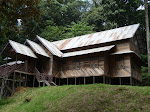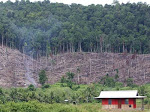Roads are ruining the rainforests
- 30 August 2009 by William Laurance
 Source: www.Newscientist.com
Source: www.Newscientist.com"THE best thing you could do for the Amazon is to bomb all the roads." That might sound like an eco-terrorist's threat, but they're actually the words of Eneas Salati, one of Brazil's most respected scientists. Thomas Lovejoy, a leading American biologist, is equally emphatic: "Roads are the seeds of tropical forest destruction."
They are quite right. Roads are rainforest killers. Without rampant road expansion, tropical forests around the world would not be vanishing at a rate of 50 football fields a minute, an assault that imperils myriad species and spews billions of tonnes of greenhouse gases into the atmosphere each year. We will never devise effective strategies to slow rainforest destruction unless we confront this reality.
In our increasingly globalised world, roads are running riot. Brazil has just punched a 1200-kilometre highway (the BR-163) into the heart of the Amazon and is in the process of building another 900-kilometre road (the BR-319) through largely pristine forest. Three new highways are slicing across the Andes, from the Amazon to the Pacific. Road networks in Sumatra are opening up some of the island's last forests to loggers and hunters. A study published in Science found that 52,000 kilometres of logging roads had appeared in the Congo basin between 1976 and 2003 (vol 316, p 1451).
As my colleagues and I reveal in a forthcoming article in Trends in Ecology and Evolution, these are just a small sample of the many new road projects slicing through tropical frontiers.
Why are roads so bad for rainforests? Tropical forests have a uniquely complex structure and humid, dark microclimate that sustain a huge number of endemic species. Many of these avoid altered habitats near roads and cannot traverse even narrow road clearings. Others run the risk of being hit by vehicles or killed by people hunting near roads. This can result in diminished or fragmented wildlife populations, and can lead to local extinctions.
In remote frontier areas, where law enforcement is often weak, new roads can open a Pandora's box of other problems, such as illegal logging, colonisation and land speculation. In Brazilian Amazonia, 95 per cent of deforestation and fires occur within 50 kilometres of roads. In Suriname, most illegal gold mines are located near roads. In tropical Africa, hunting is significantly more intensive near roads.
Environmental disasters often begin as a narrow slice into the forest. Rainforests are found mostly in developing nations where there are strong economic incentives to provide access to logging, oil and mineral operations and agribusiness. Once the way is open, waves of legal and illegal road expansion follow. For instance, the Belém-Brasília highway, completed in the 1970s, has developed into a 400-kilometre-wide swathe of forest destruction across the eastern Amazon.
Beyond the forest itself, frontier roads imperil many indigenous peoples, especially those trying to live with limited contact with outsiders. As I write, indigenous groups in the Peruvian Amazon are stridently protesting the proliferation of new oil, gas and logging roads into their traditional territories. The roads bring loggers, gold miners and ranchers who often subjugate the indigenous people. Even worse, the invaders can bring in deadly new diseases.
Throughout the tropics, infections such as malaria, dengue fever, enteric pathogens and HIV have all been shown to rise sharply after new roads are built. Some indigenous groups, such as the Surui tribe of Brazilian Amazonia, have been driven to the edge of extinction by roads and the invading loggers, colonists and diseases they bring.
What can we do to slow the onslaught? First, we must vastly improve environmental impact assessments for planned roads. In many developing nations, EIAs focus solely on the roads themselves, completely ignoring the knock-on effects. In Brazil, for instance, EIAs for Amazonian highways focus only on a narrow swathe along the route, often recommending only paltry mitigation measures, such as helping animals to relocate before building begins. EIAs for certain mines, hydroelectric dams and other large developments focus only on the project itself while ignoring the impact of the roads it will invariably spawn. New roads will continue to drive rainforest destruction so long as the EIA process is so fundamentally flawed.
The second thing we have to do is fight to keep the most destructive roads from being built - the ones that penetrate pristine frontier areas. There is no shortage of battles to wage. A proposed highway between Colombia and Panama, for example, would expose one of the world's most biologically important areas, the Chocó-Darién wilderness, to rampant destruction. Likewise, Brazil's BR-319 highway is threatening to open up the central Amazon like a zipper.
Brazil's BR-319 highway is threatening to open up the central Amazon region like a zipper
Finally, we need to pressure those promoting these frontier roads. These include timber corporations like Asia Pulp & Paper and Rimbunan Hijau, international lenders such as the Asian, African and Inter-American Development Banks, and massive infrastructure schemes such as Brazil's Programme to Accelerate Growth. In their scramble for tropical timber, minerals, oil and agricultural products, China and its corporations have become perhaps the biggest drivers of destructive road expansion.
Restricting frontier roads is by far the most realistic and cost-effective approach to conserving rainforests and their amazing biodiversity and climate-stabilising capacity. As Pandora quickly learned, it is far harder to thrust the evils of the world back into the box than to simply keep it closed in the first place.
William Laurance is a research professor at James Cook University in Cairns, Australia, and the Smithsonian Tropical Research Institute in Panama





